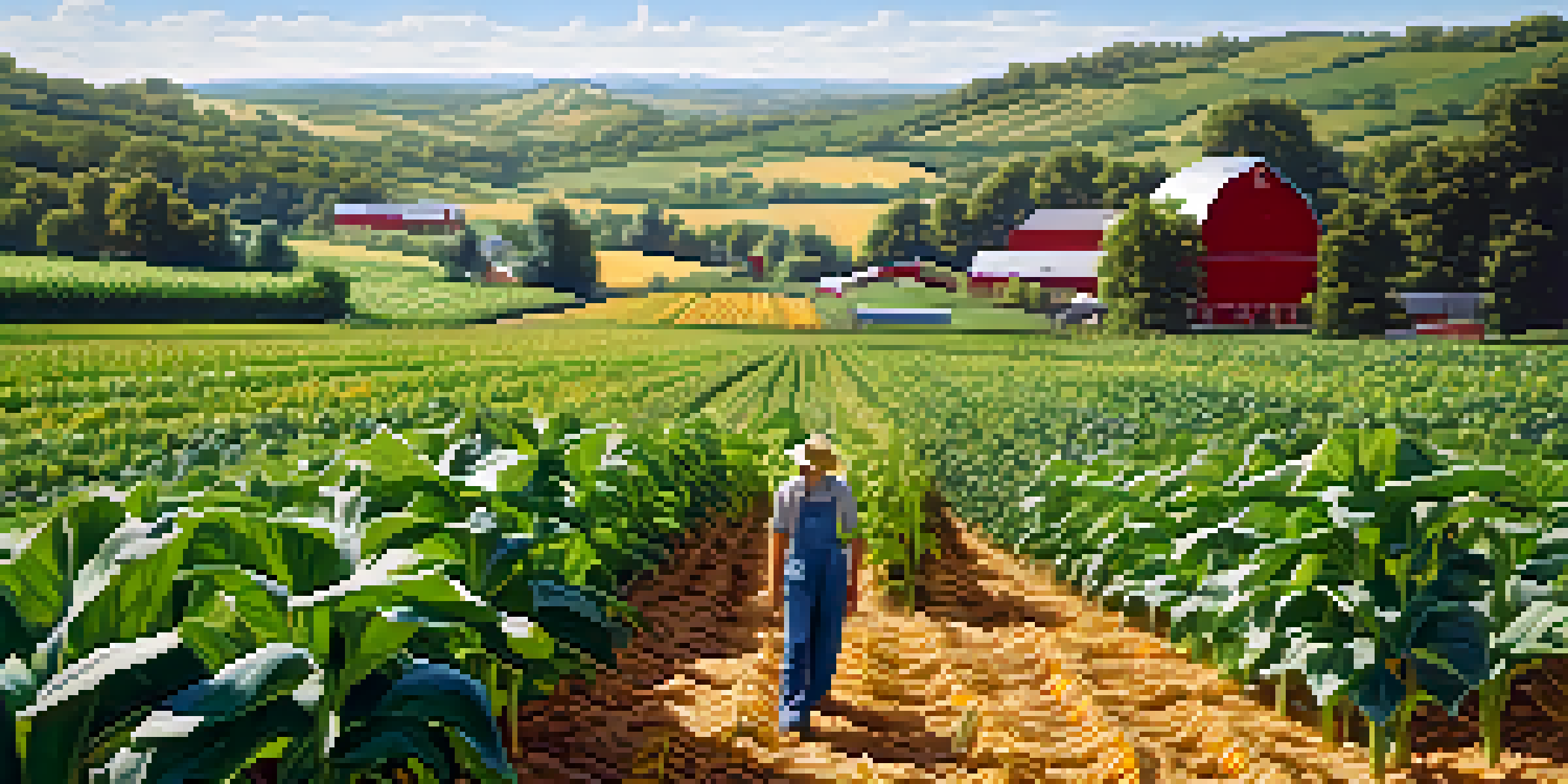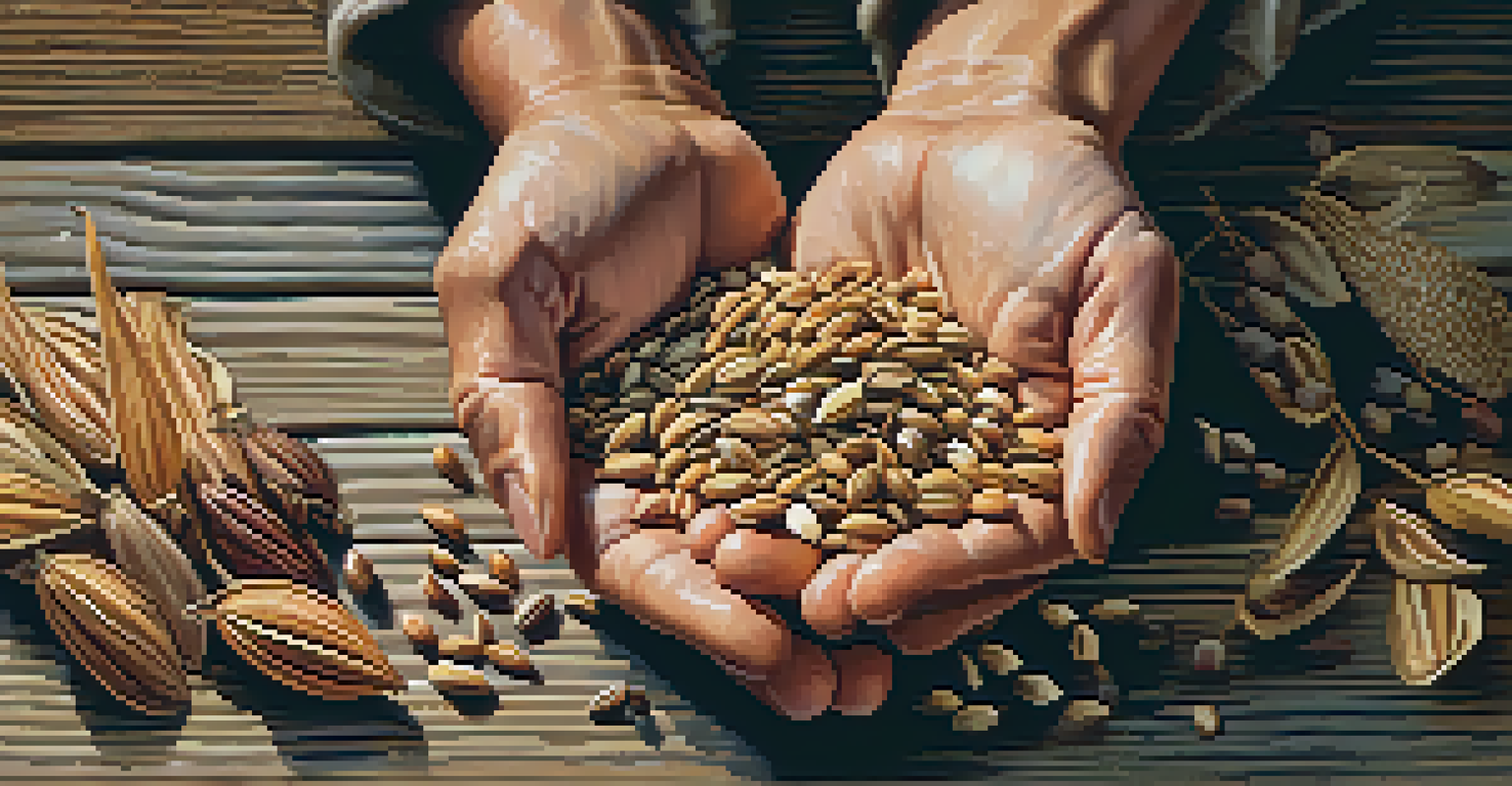The Importance of Crop Diversity in Sustainable Agriculture

Understanding Crop Diversity and Its Benefits
Crop diversity refers to the variety of different crops grown in a specific area. This can include different species, varieties, and genetic types of plants. By cultivating a wide range of crops, farmers can enhance their resilience against pests, diseases, and changing climate conditions.
The diversity of life is the key to the resilience of ecosystems, which is crucial for sustainable agriculture.
For example, if a farmer only grows one type of crop, a single pest outbreak could wipe out their entire yield. However, by incorporating multiple crops, the risk is spread out, and some plants may thrive even when others falter. This diversity acts like a safety net for farmers, ensuring more stable harvests.
Additionally, diverse crops can improve soil health and reduce the need for chemical fertilizers. Different plants contribute various nutrients to the soil and can even support beneficial microorganisms. This leads to a healthier ecosystem on the farm.
Enhancing Resilience Through Crop Diversity
Resilience in agriculture means the ability to withstand shocks such as droughts, floods, or pest invasions. Crop diversity plays a crucial role in this resilience. For instance, drought-resistant varieties of crops can be planted alongside more water-dependent ones, ensuring that at least part of the harvest can be salvaged during dry spells.

Moreover, diverse ecosystems tend to self-regulate, which means that natural pest control can occur more effectively. When multiple crops attract a variety of insects, beneficial species can keep harmful ones in check without the need for chemical pesticides.
Crop Diversity Enhances Resilience
By cultivating a variety of crops, farmers can better withstand pests, diseases, and climate challenges.
This balance not only supports the farmer but also benefits the environment by reducing chemical runoff and creating a more sustainable agricultural practice overall.
Economic Advantages of Crop Diversity
Crop diversity isn't just good for the environment; it can also be a smart financial decision for farmers. By growing multiple crops, farmers can tap into various markets and reduce their reliance on a single crop's price fluctuations. This financial buffer can be crucial for maintaining a stable income.
In nature, nothing exists alone. Diversity is not just a good idea; it's a critical necessity for survival.
For example, during a year when one crop fails due to disease, other crops might still yield a profit, allowing the farmer to stay afloat. This diversified income stream can help farmers invest in their land and improve their farming practices.
Furthermore, consumers are increasingly seeking diverse produce options, which can lead to higher demand and better prices for unusual or heirloom varieties. Farmers who embrace diversity can capitalize on this trend.
The Role of Tradition in Crop Diversity
Many traditional farming practices around the world emphasize the importance of crop diversity. Indigenous communities have long understood that growing a variety of crops not only supports their diets but also strengthens their agricultural resilience. These time-tested methods often involve rotating crops and intercropping, which are effective in maintaining soil health.
For instance, the 'Three Sisters' planting method used by Native Americans involves growing corn, beans, and squash together. Each plant supports the others in various ways, creating a symbiotic relationship that enhances growth and productivity.
Economic Benefits from Diverse Crops
Growing multiple crops allows farmers to access different markets and mitigate financial risks from crop failures.
By learning from these traditional practices, modern agriculture can find sustainable paths forward, blending old wisdom with new technology.
Crop Diversity and Climate Change Adaptation
Climate change poses significant challenges to agriculture, including altered growing seasons and unpredictable weather patterns. Crop diversity can be a key strategy for adaptation. By planting a mix of species that thrive under different conditions, farmers can ensure that at least some crops will succeed, regardless of climate fluctuations.
For example, farmers might choose to cultivate both heat-tolerant and cool-weather crops. This way, they can maximize their harvests over the changing seasons and conditions. This flexibility is vital as climate patterns continue to evolve.
Additionally, crop diversity can contribute to carbon sequestration, helping mitigate climate change effects. Diverse root systems can capture more carbon from the atmosphere, promoting a healthier planet.
Community Benefits of Crop Diversity
Crop diversity also extends its benefits to local communities. A variety of crops can lead to a more nutritious food system, as different plants provide different vitamins and minerals. This diversity on the plate can help combat malnutrition and promote better health.
Moreover, when farmers grow diverse crops, they often engage with local markets and consumers. This connection fosters a sense of community and helps build local economies. People can support their neighbors while enjoying fresh, locally grown produce.
Community and Health Improvements
A diverse range of crops contributes to better nutrition and strengthens local economies through community engagement.
In this way, crop diversity doesn’t just support individual farmers; it enhances the social fabric of communities, promoting sustainability on multiple levels.
Future Directions in Promoting Crop Diversity
As we look to the future, promoting crop diversity will be essential in addressing global food security challenges. Innovative practices, such as agroecology and permaculture, are gaining traction, focusing on diverse planting systems that mimic natural ecosystems. These approaches can yield not only more food but healthier food.
Research into seed banks and the preservation of heirloom varieties is also crucial. By maintaining a library of diverse genetic resources, we can ensure that farmers have access to a wide range of crops that can adapt to changing conditions.

Encouraging policies that support crop diversity, such as subsidies for diverse plantings or educational programs for farmers, will be vital in creating a resilient agricultural future.